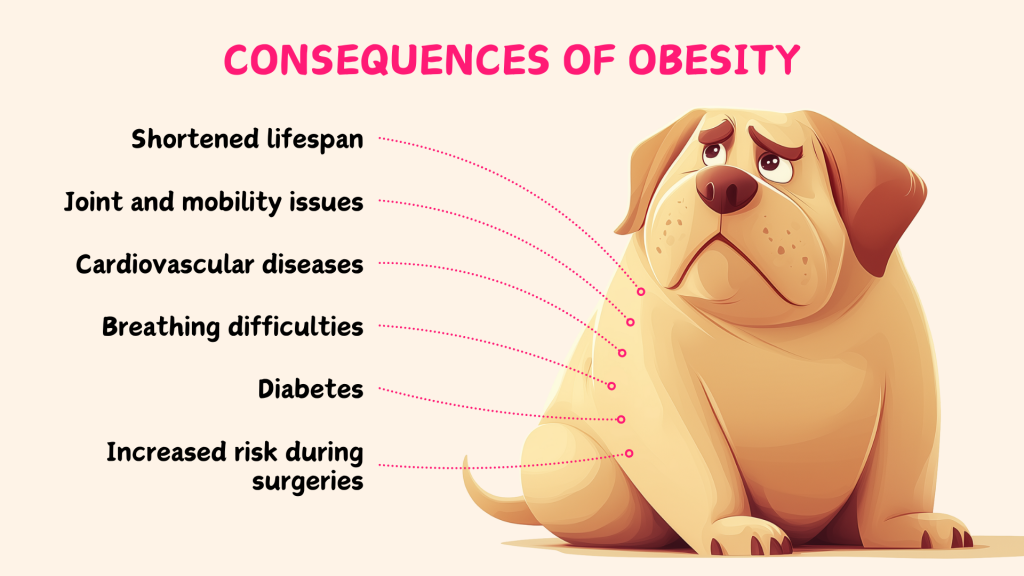Obesity in dogs is not just an aesthetic issue, but a serious health condition with widespread consequences. Prevention and treatment require the owners’ commitment, lifestyle adjustments for the dog, and regular consultations with a veterinarian. With a balanced diet, adequate physical activity, and careful monitoring, we can prevent many health problems and ensure our dogs remain healthy, active, and long-lived.
-
Dr. Timi
- 2. December, 2024
Obesity in dogs

Obesity in dogs is an increasingly common health problem that affects about one-third of pets worldwide. It is a chronic condition where excess body fat accumulates, negatively impacting the dog’s health and quality of life. Obesity is often underestimated as owners associate it only with aesthetic concerns, but its health consequences can be serious and even life-threatening. In this article, we will break down the causes, consequences, methods of recognition, and a comprehensive plan for the prevention and treatment of obesity in dogs.
Causes of Obesity in Dogs
Obesity is always the result of an imbalance between energy intake (food) and energy expenditure (activity), but several factors can accelerate this imbalance:
Excessive food intake
Owners often give dogs more food than they need, without considering the animal’s age, size, and activity level.
Treats and inappropriate or human food: Frequent giving of treats and leftovers from human food quickly increases caloric intake. For example, a small piece of cheese for a medium-sized dog is energetically equivalent to a fast food meal for a human.
Lack of exercise
Modern dogs often live in apartments and do not have enough opportunities for physical activity. Owners may, due to a lack of time, walk their dog only briefly or may not include them in regular exercise at all.
Genetic predisposition
Some breeds are genetically predisposed to obesity. This includes Labradors, Cocker Spaniels, Pugs, Dachshunds, and other breeds. In Labradors, it has been found that some carry the POMC gene, which is responsible for increased hunger and, consequently, obesity.
Age and metabolism
Metabolism slows down with age, which means older dogs require fewer calories. If owners do not adjust their meals to the aging process, the dog will start gaining weight.
Hormonal disorders
Conditions such as hypothyroidism (underactive thyroid) or Cushing’s disease can lead to weight gain, even if the dog is on a strict diet.
Spaying and neutering
After spaying or neutering, the levels of certain hormones change, which can lead to a decrease in metabolism and an increase in appetite. Owners often do not adjust the dog’s diet and activity level after these procedures, leading to obesity.
Consequences of obesity in dogs

Obesity negatively affects nearly all aspects of a dog’s health. The consequences include:
Joint and Movement Problems
Excess body weight increases pressure on the joints, which can lead to osteoarthritis, cruciate ligament injury, or hip dysplasia. Obese dogs often show signs of pain and limping, which further reduces their movement and accelerates the vicious cycle.
Cardiovascular Diseases
Obese dogs have an increased risk of heart failure, high blood pressure, and circulation problems. The heart has to work harder due to excess weight, which puts additional strain on it.
Diabetes Mellitus
Obesity reduces the body’s sensitivity to insulin, leading to imbalances in blood sugar levels, which can cause diabetes. This condition requires strict dietary adjustments and insulin treatment.
Breathing Problems
Excess fat makes breathing more difficult, especially in breeds with short snouts (e.g., pugs, bulldogs). This results in labored breathing, snoring, and decreased tolerance to physical activity.
Increased Surgical Risk
Anesthesia for obese dogs carries higher risks due to breathing and circulation problems. Surgical procedures are also more technically challenging for obese dogs.
Shortened Lifespan
Studies show that obese dogs have a shorter lifespan by about two years compared to their leaner counterparts.
How to Recognize Obesity in a Dog?
Body weight assessment in dogs is based on the Body Condition Score (BCS), which ranks dogs on a scale from 1 (severe malnutrition) to 9 (severe obesity). There are 5 and 9-point systems. In the 9-point scale:
Ideal Body Condition (4–5)
Ribs are easily palpable, the waist is clearly visible from above, and the abdomen is slightly tucked.
Obesity (7–9)
Ribs are no longer palpable, the waist is not visible, and the abdomen is sagging. Regularly weighing the dog and tracking changes in body weight are crucial for the early detection of obesity.

Treatment of Obesity in Dogs
Treating obesity is a long-term process that requires a comprehensive approach:
Dietary Adjustment
Switch to a low-calorie diet that is high in fiber and low in fat. A veterinarian can recommend a specialized diet tailored to the dog’s specific needs. Strictly monitor portion sizes and avoid human food and extra treats.
Gradual Increase in Physical Activity
Start with moderate physical activity, such as short walks, and gradually increase it. Dogs that have had health problems due to obesity require customized exercise programs under the supervision of a veterinarian or physiotherapist. Games that encourage movement, such as fetching balls or tug-of-war, can be used. Consult with the veterinarian about any dietary supplements or medications that may help improve metabolism.
Regular Progress Monitoring
Dogs should lose no more than 1–2% of their body weight per week to avoid metabolic problems. Regular veterinary visits are crucial for assessing progress.
Prevention of Obesity in Dogs
Maintaining Ideal Weight
Proper food portioning and regular exercise are key to preventing obesity. For neutered or spayed dogs, calorie intake should be reduced by approximately 20% to prevent weight gain. Owners often underestimate the impact of treats and leftover food.
Timely Action
If you notice your dog gaining weight, immediately adjust its diet and activity levels and consult a veterinarian.
